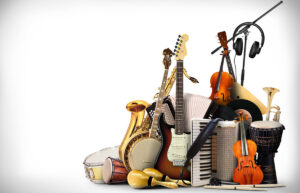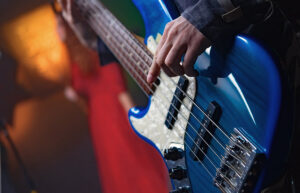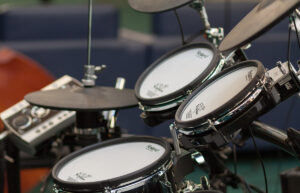A Beginner’s Guide to the Bass Guitar

Another One Bites the Dust! How can you miss the thumping and racy twiddling by John Deacon as Freddie Mercury powers through the vocals? Too low-pitched for the electric guitar and distinct from the unplugged tones of the acoustic guitar, the iconic medley is played on the bass guitar. Much of the heart of the song is in the bass. In this blog, we capture the essence of the bass guitar, journey through its captivating history, and unveil its profound role in various genres of music. Gain insights into the anatomy of the bass guitar and master the fundamentals of playing it. Moreover, delve into priceless tips for enhancing your bass guitar skills and become acquainted with legendary musicians who have made their mark playing this iconic instrument.
Welcome to TheDemoStop, now join the community!
Connect with artists, fans and producers around the world.
What is a bass guitar?
Ever seen a bass guitarist in action? Right from the energy-driven power-packed performance of Cliff Burton, Robert Trujilo, and John Myung to the rollicking fun of Victor Wooten, Jaco Pastorius, and Flea, bass guitarists have imbued their soul into the instrument to create magical eclectic tones.
The bass guitar is an essential component of modern music, renowned for deep and rhythmic tones. Although the bass guitar closely resembles an electric guitar, it features a larger body with an extended neck. This instrument is specially designed to produce low-pitched notes that provide music its characteristic thump and energy. Advanced bass players have been known to play with more strings for enhanced tonality and musical complexity.
Unlike the regular six-stringed electric or acoustic guitar, the bass guitar is typically a four-stringed instrument that maintains the rhythm with drums and reinforces harmonies in a musical composition. Played by plucking or slapping the strings, the bass guitar spans various genres from rock and jazz to funk and pop, making it indispensable in contemporary music. The bass guitar lays the foundation for the groove and structure of a song, contributing depth and richness with its distinct deep tones and extended neck.
History of bass guitar
The history of the bass guitar is a fascinating journey that traces its origin back to the early 1930s. Musicians of that era were experimenting with musical instruments to produce deeper, lower-pitched sounds that could better anchor the rhythm in bands and orchestras. In the 1930s, one of the earliest prototypes of the bass guitar–the Frying Pan–was designed by Paul Tutmarc.
However, the introduction of the Precision Bass by Leo Fender in 1951 marked a pivotal moment in the instrument’s history. Often referred to as the P-Bass, this was the first mass-produced electric bass guitar and quickly gained immense popularity.
In the following years, other iconic bass guitar models, such as the Jazz Bass and the Rickenbacker 4000 series, emerged. These instruments played a vital role in shaping popular music, particularly in genres such as rock, funk, and jazz. Visionary bassists like James Jamerson quickly adapted their playing and pushed the boundaries of tonality and musical expression that the bass guitar could achieve.
As time progressed, the bass guitar became an integral part of popular music, especially in rock, funk, and various other genres. Different styles and variations of the bass guitar, including the legendary Fender Jazz Bass, expanded the tonal possibilities of this instrument.
Today, the bass guitar continues to hold a significant place in music, providing the crucial low-frequency foundation that propels the rhythm and groove of countless songs. Its evolution reflects the ever-changing landscape of music and its ability to adapt to different genres and playing techniques, making it an essential part of the music world’s history.
Importance of bass guitar in music
Would The Who’s “My Generation” sound the same without the wizardry of John Entwistle on the bass? Probably not! Would Michael Jackson be as smooth in his dance moves in “Billie Jean” without the bass groove? I bet he would probably stop his dance mid-song and rush to get the music sorted. Would we swoon to the lows and high of “Come Together” by the Beatles? No way!
The importance of bass guitar in music is profound and cannot be overstated. This instrument is the unshakable foundation for compositions. Music emanating from the bass guitar is the bridge that links rhythm and melody, ensuring that a song grooves and resonates with depth. The bass guitar adds resonance, movement, and an undeniably captivating quality to various music genres. Whether it’s the steady heartbeat of a rock song, the funky pulse of a jazz piece, or the smooth groove in a pop track, the bass guitar’s role is indispensable. In the hands of an experienced player, the bass guitar can provide subtle harmonies, intricate solos, and everything in between. The bass guitar is not merely an accompaniment, it’s an instrument that shapes the emotional essence of a song, connecting listeners to the very core of music.
Types of bass guitars
Bass guitars come in various types, each with its unique characteristics and sounds, catering to different playing styles and musical genres. Here’s a brief overview of the key types of bass guitar:
Acoustic bass guitars

Acoustic bass guitars are designed for amplified sound and have a hollow body like acoustic guitars, offering warm and natural tones, suitable for unplugged performances.
Fretless bass guitars

These basses lack traditional frets, allowing for smooth glissando and expressive playing, but requiring precise finger placement for accurate pitches.
Fanned fret basses

They feature frets that are not parallel, with longer scale lengths on lower strings and shorter scale lengths on higher strings. This design optimizes intonation and string tension for each string.
Upright bass

Also known as the double bass or contrabass, the upright bass is a large, bowed, or plucked string instrument commonly used in classical, jazz, and some contemporary genres. Upright bassists often play standing or seated.
Ukulele bass

Compact with shorter scales, they resemble ukuleles but have thicker bodies and rubber or synthetic strings. They produce a unique, bright, and percussive sound.
Welcome to TheDemoStop, now join the community!
Connect with artists, fans and producers around the world.
Anatomy of a bass guitar

The anatomy of a bass guitar encompasses various components that collectively shape the instrument and influence its sound. These components work together to create the distinctive tones and playability that bassists rely on. I remember how naive I was when I bought my first bass guitar. I was in my late teens, adulthood was yet to hit me (when it did, it hit hard!). I walked into the guitar store hoping to buy an electric guitar to upgrade from the second-hand acoustic guitar that was near the end of its lifecycle. To the amusement of my parents and to my own surprise, I walked out of the store buying a bass guitar. It just felt right! But I wish I had some knowledge of the anatomy of the bass guitar before I burned a hole in my dad’s pocket. Ol’ Daddy O chuckled as he paid for the guitar.
- Tuning heads: Situated on the headstock, tuning heads are used to adjust the tension of each string, allowing precise tuning. A finely tuned guitar gives a good tone, but a poorly tuned guitar is dissonant and warbling. Therefore, tuning the guitar strings to the right pitch is essential. The machine heads allow you to do just that.
- String tree: A string tree helps maintain the proper break angle of the strings, enhancing stability and sustain. Do note not all guitars have strings.
- Truss rod cover: Located on the headstock, the truss rod cover conceals the truss rod adjustment mechanism.
- Nut: This small piece at the top of the neck sets the string spacing and height, significantly affecting playability.
- Neck: The neck supports the fretboard and strings, making it a crucial component for playability and sound.
- Fretboard: Players press down on the strings on the fretboard to create different notes. Fretboards are typically made from materials such as rosewood or maple.
- Frets: Frets are metal strips embedded in the fretboard. Every fret for every string plays differently. By pressing a string down behind a fret, the length of the string is shortened, resulting in different pitches.
- Truss rod: Found inside the neck, the truss rod is adjustable and helps control the neck’s curvature, which can affect payability and string action.
- Inlays: These are decorative markers on the fretboard, usually found at specific fret positions, often at the 3rd, 5th, 7th, 9th, and 12th frets.
- Skunk stripe: This is a strip of wood on the back of the neck, visible primarily from the rear of the bass and used to cover the truss rod channel.
- Body: The body of the bass guitar is where the sound is generated and resonates. It comes in various shapes and sizes, each influencing the sound of the instrument.
- Strap buttons: Attached to the body, these buttons enable players to attach a strap for standing and playing the bass guitar.
How to play bass guitar
Two days after my purchase, the second-hand acoustic finally gave way and died a rather torturous death. Maybe it envied the brand new bass and knew its time was up or maybe I pressed too hard (unintentionally, I swear), and that was it! With a final wail and an ungodly twang from its rusted strings, it came apart from the stock, body, and fretboard and split into two as I tried Hotel California (way above my skill level at that stage). I could almost imagine the new guitar gloating over the old guitar. From then on, the bass was my world. Playing the bass surpassed eating, sleeping, and occasionally even playing with my friends.
Bass playing was an exciting journey. I only wish my approach was structured. Haphazard learning of tunes and songs hindered my progress. With my years of experience, I can now share tips with budding guitar players. If I could time travel to the past, I would be reaching to my frustrated, often daft, and clueless past self and hand him the goof this guideline:
Get to know the different parts of a bass guitar
Start by understanding the different parts of a bass guitar. This foundational knowledge, including the tuners, strings, frets, pickups, and controls, will help players navigate the bass guitar effectively.
Get a bass guitar for beginners
You are only as good as your bass, said no one ever! It’s advisable to begin with a four-string bass guitar, which is more accessible for newcomers. This type is versatile and suitable for various music styles. I know you want to rock the five-string or the six-string instrument but trust me, jumping ship too soon would do more harm than good. A rich friend of mine and I started at the same time. He would flaunt his rather expensive guitar. My humble-brand bass stood nowhere compared with his bass. To this day, his fundamentals are unclear, his passion withered, and his bass lying forgotten in the attic somewhere. What a horrible fate for a finely crafted bass! You wouldn’t want a novelty to impinge on your learning, would you?
Learn how to hold the instrument
Maybe this is not emphasized enough. In the early lessons, learning how to hold the bass guitar correctly is essential. It ensures comfort and ease of playing. Players should grasp the correct hand positioning, body posture, and strap adjustment to avoid subsequent injuries. Doing mad hops and crazy tricks can wait! Get the playing pose right, dammit!
Learn how to tune a bass guitar
Tuning is vital for staying in harmony with other musicians. Becoming familiar with standard tuning (E-A-D-G) is necessary. Leave the alternative tunings for later play. Because the human ear is tone deaf and prone to errors, I recommend using a good tuner or a mobile phone application to help you with your playing.
Choose between playing with a pick or your fingers
Play both! Some songs play exceptionally well on finger, whereas others are more suited with a pick. Experiment with both techniques to find what suits one’s style best. For a player with no experience, you can go ahead with finger playing and then switch to picking style. If you are accustomed to playing with the pick for your acoustic guitar, I would suggest you continue with it initially and slowly wean yourself off the pick to try finger plucking bass.
Get familiar with bass tablature
Learning to read bass tablature (tabs) is a crucial skill. Some musicians may argue that most God-level guitar players do not know tablature. True! I do not deny that fact. However, if you want to become an accomplished and polished musician, learning to read the tabs is a must. The tablature offers a visual representation of music tailored specially for the bass guitar, making it easier to follow bass lines. After a certain level, you would be called out for your lack of knowledge of music theory. Imagine how embarrassing it would be if you get on stage to play with a different band than your regular one and you tell them you simply can’t play the song for the band because you can’t read the tabs. Chances are the lead guitarist or vocalist could up to you and give a jab or a tight slap because you played truant when it came learning how to read the tabs!
Welcome to TheDemoStop, now join the community!
Connect with artists, fans and producers around the world.
Play your first bass line
Begin with simple bass lines or melodies to practice playing. Many beginner bass tabs for popular songs are available online. Please spare yourself (mind, body, and fingers) and do not pick up the hardest bass lines you come across.
Use metronome
It is essential to get your timing right. How else are you going to match up with the drummer of your band? Will you be in sync with the lead and rhythm guitarist without practicing? Investing in that beeper and setting it to different times is essential.
Set up a routing for playing the bass
Pick up that axe and grind! Regular practice is essential to become proficient. Work on finger strength, dexterity, timing, and rhythm. Exploring different exercises will improve bass guitar skills. Rome was not built in a day, nor was a great bass guitar maestro just born genius.
Tips for playing bass guitar
Enhancing your bass guitar skills is a rewarding journey that calls for dedication and practice. Here are some valuable tips for playing bass guitar:
Invest in a good tutor or an online course
A good bass guitar tutor can boost your playing and help unlock your potential. At least initially, hiring a tutor is recommended to get your basics right. Numerous online tutorials have mushroomed over the years. For a subscription fee, they let you access bass guitar content and lessons. Use the trial period to understand if the lessons are up to your level and interface is intuitive and easy to use.
Be in tune
Accurate tuning is critical for harmonious sound and playing in tune with the rest of the band. Regularly tune your bass guitar.
Focus on roots and rhythm
As a bassist, your role is to provide the foundation for music. Concentrate on playing the root notes of the chords to establish the harmonic structure. Music theory comes into play here. Implement the circle of fifths and other helpful lessons as much as you can.
Focus on technique
Work on your technique diligently. Whether you are using fingerstyle or a pick, precision in your playing is key. Good hand coordination is essential.
Work on your ear and groove
A great bass player has a sense of groove that breathes life into a track. Listen carefully to different styles of music and hone your groove to match. Get creative only when you are through with the basics. Keep experimenting and push your boundaries.
Play in sync with the band
Once you have learned the basics and nailed your timings on the bass guitar, form a band with your buddies. They may not be professional, but at this stage, neither are you. Play at local venues as much as you can. With acoustic and electric guitar greatly outnumbering bass players, you’ll be in demand. A solid sense of timing and rhythm is fundamental. Sync up with the drummer to lock in the groove and ensure the entire band stays on beat the whole track.
Have fun
Music is a form of expression, so let your passion shine through your playing and enjoy every moment of it. Remember to have fun. You can only get so far by pursuing technicality. Innovation and creativity should come from within. Let the musician in you bloom!
Famous musicians who played bass guitar

Numerous musicians have gained acclaim playing the bass guitar, leaving an indelible mark on the world of music. These artists, hailing from diverse genres and backgrounds, have demonstrated the incredible versatility and impact of the bass guitar. Here are some iconic musicians that I believe stand out among bass guitarists:
Paul McCartney
As a member of the legendary band The Beatles, Paul McCartney was my favorite beatle. He not only shaped the sound of the 1960s but also showcased the melodic potential of the bass guitar. His innovative bass lines remain an integral part of the Beatles’ timeless music. Classics like “Let It Be”, “Hey Jude”, and “Yesterday” are timeless treasures of his talent. He had a knack for the Hofner 500/1 bass guitar, which became synonymous with his image. The bass lines in songs like “Come Together” and “Something” still continue to resonate with me.
Jaco Pastorius
Jaco Pastorius, the virtuoso of the fretless bass, transformed the world of jazz with his innovative compositions. His work with Weather Report, especially in “Birdland,” showcased his groundbreaking approach to bass playing. His fretless Jazz Bass was a legend in itself, giving voice to his unique musical expressions.
Bootsy Collins
Boosty Collins, the funk icon, is another legend. His bass lines in Parliament-Funkadelic’s hits set the stage for countless groovy basslines in funk music. His “Space Bass” is as legendary as the man himself. Tracks like “I’d Rather Be with You” and “Stretchin’ Out (In a Rubber Band),” showcase his virtuosity and rhythm that makes you dance.
John Entwistle
John Entwistle, often referred to as “The Ox,” was the rock-solid foundation of The Who. His pioneering use of the bass guitar as a lead instrument is something I truly admire. He wielded a Fender Precision Bass, a choice that influenced countless rock bassists. His thundering bass lines were the backbone of The Who’s powerful sound, and tracks like “The Real Me” and “Boris the Spider,” are a masterclass in bass playing.
James Jamerson
James Jamerson, the Motown session bassist, is someone whose legacy lives on. His impeccable bass lines are nothing short of magical. The bassline in “What’s Going On” by Marvin Gaye is iconic, and the fact that he played it on his Fender Precision Bass just adds to the legend. Jamerson’s ability to infuse soul and groove into every note he played is unparalleled.
Welcome to TheDemoStop, now join the community!
Connect with artists, fans and producers around the world.
Summary
This comprehensive guide to the bass guitar has shed light on various aspects of this remarkable instrument. Here are the key takeaways:
- Understanding the bass guitar: The bass guitar plays a fundamental role in music, providing the rhythmic and harmonic foundation for countless genres.
- Historical journey: From its humble beginnings in the early 1930s to its evolution into a pivotal force in modern music, the bass guitar’s history is a testament to its significance.
- Importance of bass guitar in music: The bass guitar serves as the musical bridge between rhythm and melody, enriching the musical texture and ensuring a captivating groove.
- Types of bass guitars: The bass guitar family includes acoustic bass guitars, fretless bass, fanned frets, upright bass, and ukulele bass, each with distinct characteristics.
- Anatomy unveiled: A comprehensive exploration of the bass guitar’s anatomy provides a deeper understanding of how each component contributes to its unique sound and playability. Key components encompass tuning heads, string tree, truss rod cover, nut, neck, fretboard, frets, truss rod, inlays, skunk stripe, body, and strap buttons.
- Learning to play bass guitar: Aspiring musicians can start their journey by familiarizing themselves with the instrument’s parts, selecting the right model, tuning it, and dedicating time to practice.
- Pro tips for playing bass guitar: Valuable tips include the importance of synchronizing with the drummer, emphasizing roots and rhythm, maintaining proper tuning, refining playing techniques, and, most importantly finding joy in playing.
- Famous musicians who played bass guitar: Musical legends such as Paul McCartney, Jaco Pastorius, Bootsy Collins, John Entwistle, and, James Jamerson have significantly shaped the world of music with their exceptional bass guitar skills.
FAQs
What is a bass guitar?
A bass guitar, known for its deep, rhythmic tones, is typically a four-stringed instrument with a low-pitch that provides groove and structure and underpins songs across various musical genres.
Why is the bass guitar important in music?
The bass guitar is essential in music as it serves as the rhythmic foundation, linking harmony and melody. Its deep, resonant tones create richness and depth in compositions, enhancing the overall listening experience.
What is the anatomy of a bass guitar?
The anatomy of a bass guitar includes key components such as tuners for tuning, a nut and fretboard for playing, frets for pitch control, and a truss rod for neck adjustment. The body generates sound, and strap buttons provide playing convenience
What are the parts of bass guitar?
The different parts of a bass guitar encompass tuners, string tree, truss rod cover, nut, neck, fretboard, frets, truss rod, inlays, skunk stripe, body, and strap buttons.
What are the different types of bass guitars?
Bass guitars come in various types to suit different styles. These include acoustic bass guitars, fretless bass, fanned frets, upright bass, and ukulele bass.
How to play bass guitar?
To play a bass guitar, start by familiarizing yourself with the instrument’s anatomy. Learn proper hand positioning and fingering techniques. Practice regularly to improve finger strength, rhythm, and timing.
How can you improve playing bass guitar?
Playing in sync with the drummer, focusing on roots and rhythm, being in tune, focusing on technique, working on your ear and groove, getting your bass set up, and having fun are some tips for good bass playing.
Who are the famous musicians who played bass guitar?
Some famous musicians known for their exceptional bass guitar skills are Paul McCartney, Jaco Pastorius, Bootsy Collins, John Entwistle, and, James Jamerson.
What makes the bass guitar unique?
The bass guitar’s uniqueness lies in its deep, low-frequency tones that provide the foundational rhythm and groove in music. With an extended neck and four strings, it focuses on maintaining the rhythm and reinforcing harmonies. This unique instrument bridges rhythm and melody, adding depth and richness to compositions across various genres.
Who invented the first bass guitar?
The first electric bass guitar, known as the “Frying Pan,” was invented by Paul Tutmarc in the early 1930s. However, it was Leo Fender who revolutionized the instrument by introducing the P-Bass in 1951, which became the first mass-produced electric bass guitar.




























